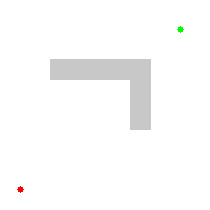Spoiler 

1
2
3
4
5
6
7
8
9
10
11
12
13
14
15
16
17
18
19
20
21
22
23
24
25
26
27
28
29
30
31
32
33
34
35
36
37
38
39
40
41
42
43
44
45
46
47
48
49
50
51
52
53
54
55
56
57
58
59
60
61
62
63
64
65
66
67
68
69
70
71
72
73
74
75
76
77
78
79
80
81
82
83
84
85
86
87
88
89
90
91
92
93
94
95
96
97
98
99
100
101
102
103
104
105
106
107
108
109
110
111
112
113
114
115
116
117
118
119
120
121
122
123
124
2
3
4
5
6
7
8
9
10
11
12
13
14
15
16
17
18
19
20
21
22
23
24
25
26
27
28
29
30
31
32
33
34
35
36
37
38
39
40
41
42
43
44
45
46
47
48
49
50
51
52
53
54
55
56
57
58
59
60
61
62
63
64
65
66
67
68
69
70
71
72
73
74
75
76
77
78
79
80
81
82
83
84
85
86
87
88
89
90
91
92
93
94
95
96
97
98
99
100
101
102
103
104
105
106
107
108
109
110
111
112
113
114
115
116
117
118
119
120
121
122
123
124
function table.empty(tab)
for k, v in pairs(tab) do
return false
end
return true
end
function FindPath(Map,fx,fy,tx,ty)
local Node = {}
local sizex = #Map
local sizey = #Map[1]
local curbase = {x = fx,y = fy}
local function Euclidean(fx,fy,tx,ty)
return math.sqrt((fx-tx)^2 + (fy-ty)^2)
end
local function Manhattan(fx,fy,tx,ty)
return math.abs(fx-tx) + math.abs(fy-ty)
end
-- To get the openlist
local function openlist()
local open = {}
for x = 0, sizex do
for y = 0, sizey do
if Node[x][y].Open then
table.insert(open,{x = x,y = y})
end
end
end
return open
end
-- To get the closedlist
local function closedlist()
local closed = {}
for x = 0, sizex do
for y = 0, sizey do
if Node[x][y].Closed then
table.insert(closed,{x = x,y = y})
end
end
end
return closed
end
-- Configurate Nodes
for x = 0, sizex do
Node[x] = {}
for y = 0, sizey do
NodeInfo = {
Open = false,
Closed = false,
G = 0,
H = Euclidean(x,y,tx,ty),
parent = {}
}
function NodeInfo.F()
return NodeInfo.G + NodeInfo.H
end
Node[x][y] = NodeInfo
end
end
Node[fx][fy].Open = true
local function FixedPath()
local i = {x = tx,y = ty}
local path = {}
while Node[i.x][i.y].parent.x and Node[i.x][i.y].parent.y do
local Details = {
x = i.x,
y = i.y,
F = Node[i.x][i.y].F(),
G = Node[i.x][i.y].G,
H = Node[i.x][i.y].H
}
table.insert(path,Details)
i = Node[i.x][i.y].parent
end
return path
end
while not table.empty(openlist()) do
local lF = nil -- Lowest F node
for k, v in pairs(openlist()) do
if not lF or Node[v.x][v.y].F() < Node[lF.x][lF.y].F() then
lF = v
msg("F: "..Node[v.x][v.y].F().." - "..v.x.." "..v.y)
end
end
msg("Lowest F: "..Node[lF.x][lF.y].F().." - "..lF.x.." "..lF.y)
Node[lF.x][lF.y].Closed = true
Node[lF.x][lF.y].Open = false
curbase = lF
if curbase.x == tx and curbase.y == ty then
return FixedPath()
end
local NearNodes = {}
local function AddNode(x,y)
if not Node[x][y].Closed and Map[x][y] == 0 then
table.insert(NearNodes,{x = x,y = y})
end
end
AddNode(curbase.x,curbase.y+1); AddNode(curbase.x+1,curbase.y)
AddNode(curbase.x,curbase.y-1); AddNode(curbase.x-1,curbase.y)
for k, v in pairs(NearNodes) do
local score = Node[curbase.x][curbase.y].G + Euclidean(curbase.x,curbase.y,v.x,v.y)
if not Node[v.x][v.y].Open then
Node[v.x][v.y].Open = true
Node[v.x][v.y].parent = curbase
Node[v.x][v.y].G = score
msg("Added Element: "..v.x.." "..v.y.." "..Node[v.x][v.y].F())
elseif score < Node[v.x][v.y].G then
Node[v.x][v.y].parent = curbase
Node[v.x][v.y].G = score
msg("Added Element: "..v.x.." "..v.y.." "..Node[v.x][v.y].F())
end
end
end
return nil, "Couldn't find the path"
end
I tested it using this other part.
Spoiler 

1
2
3
4
5
6
7
8
9
10
11
12
13
14
15
16
17
18
19
20
21
22
23
24
25
26
27
28
29
30
31
32
33
34
35
36
37
38
39
40
41
42
43
44
45
46
47
48
49
2
3
4
5
6
7
8
9
10
11
12
13
14
15
16
17
18
19
20
21
22
23
24
25
26
27
28
29
30
31
32
33
34
35
36
37
38
39
40
41
42
43
44
45
46
47
48
49
function string:split(b)
local cmd = {}
if type(self) == "string" then
if not b then match = "[^%s]+" else match = "[^"..b.."]+" end
for word in string.gmatch(self,match) do
table.insert(cmd,word)
end
end
return cmd
end
PathSprites = {}
addhook("say","onSay")
function onSay(id,txt)
local s = txt:split()
if s[1] == "mypos" then
msg2(id,"X: "..player(id,"tilex").." Y: "..player(id,"tiley"))
elseif s[1] == "path" then
local fx,fy,tx,ty = tonumber(s[2]),tonumber(s[3]),tonumber(s[4]),tonumber(s[5])
if not fx or not fy or not tx or not ty then return 0 end
local Map = {}
for x = 0, map("xsize")+1 do
Map[x] = {}
for y = 0, map("ysize")+1 do
if tile(x,y,"walkable") then
Map[x][y] = 0
else
Map[x][y] = 1
end
end
end
local p,err = FindPath(Map,fx,fy,tx,ty)
if p == nil or err then
msg(err)
if p == nil then
return 0
end
end
for k, img in pairs(PathSprites) do
freeimage(img)
end
PathSprites = {}
for k, v in pairs(p) do
local img = image("gfx/sprites/block.bmp",0,1,1)
imagepos(img,(v.x*32)+16,(v.y*32)+16,0)
table.insert(PathSprites,img)
end
end
end
Try to use it in de_dust, with the coords:
1
X: 37 Y: 4
1
X: 37 Y: 6
It will give you a wrong path, anyways its a walkable path.
My Opinion: I think at the part you search a low G cost, I made something wrong.

 Doubt with A* Pathfinding
Doubt with A* Pathfinding
 1
1 
 Offline
Offline


